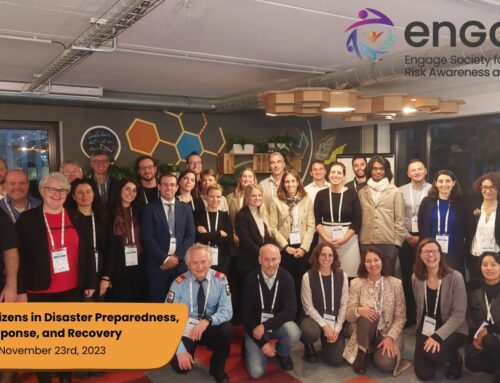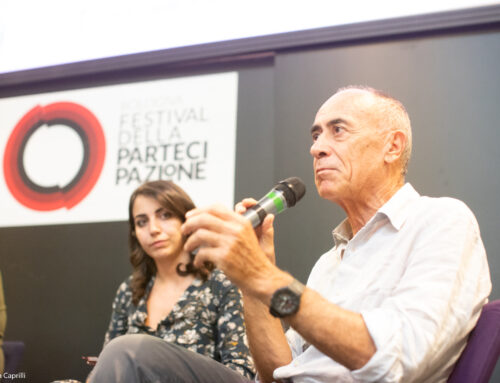Photos compliments of One2Many, an Everbridge Company
As a software company active in empowering resilience, we are aware of how crucial effective communication is, especially in times of emergencies. One2Many, an Everbridge company, as a partner of the Horizon 2020 research project-ENGAGE (www.project-engage.eu), has started developing an AI-enabled chatbot to advance emergency management and enhance disaster risk resilience. To achieve this ambitious goal, One2many enlisted the expertise of a group of talented students from Saxion University of Applied Sciences.
This blog post highlights the incredible journey of these students as they contributed to the development of the innovative chatbot, discussing their strategic approach, the challenges they encountered, and the transformative potential of their work for increasing societal resilience to risk.
Saxion University of Applied Sciences has a reputation for providing students with hands-on training, enabling them to develop practical skills and apply them in real-world projects. One2many recognized the immense value these students could bring to the ENGAGE project, having experience with previous Saxion students already on other product-related projects in the company. By involving students, One2many gains access to a talented pool of individuals who provide practical insights and accelerate the development of the chatbot prototype, while offering them an invaluable opportunity to apply their skills in a real working environment.
Making the chatbot prototype more modular and adaptable for future AI solutions is one of the key challenges we faced. Recognizing the rapidly evolving nature of AI technology, the students took a proactive approach to ensure the chatbot’s longevity. They meticulously designed the architecture of the chatbot, focusing on modularity and scalability, enabling easy integration of new AI advancements as they become available. This forward-thinking approach ensured that the chatbot remains relevant and future-proof, capable of leveraging cutting-edge AI techniques.
Unveiling the Limitations of Current Chatbot Implementation
Since we were aware of the limitations of the existing chatbot prototype, we organized the student work with this in mind. The original AI-enabled chatbot prototype, using Google Dialogflow, was restricted to web browser access and relied on intent-driven interactions. However, the goal was to create a more versatile and accessible chatbot that could operate seamlessly across multiple channels, including voice, SMS, and smart assistants like Alexa and Siri. Moreover, incorporating diverse AI solutions, such as ChatGPT, which operates differently from intents, presented an additional challenge.
The Student Project: Refactoring and Modularization
Embarking on an intensive eight-week project, the student group embraced the task of refactoring the existing monolithic chatbot. Their primary objectives included modularizing the codebase, implementing other AI models, exploring the Flutter framework and Dart programming language, and ensuring accessibility across various communication channels. To achieve these goals, the students devised a plan to split the project into different interfaces, accommodating diverse methods of client communication.
Strategic Approach and Implementation
To maintain consistency, the team opted to continue using DART for the backend development, as the current prototype was already built with the Flutter Framework using DART. They thoroughly analysed the existing codebase, crafted a comprehensive solution blueprint, outlined technical aspects, and diligently distributed the workload among team members. Their proposed solution aimed to create an AI driver capable of seamlessly integrating various AI solutions, such as Dialogflow’s intent-driven model and ChatGPT’s prompt-based approach. Another benefit of making the AI driver separate is enabling SMS or Voice to be connected through a straightforward and simple implementation of SMS/Voice frontend.
Creating a Future-Proof Concept
Implementing a successful AI driver required a deep understanding of the current setup and careful planning for future expansions. Presently, the chatbot resides within the Mobile/Web Interface, relying on Dialogflow for intent-based interactions. However, introducing an AI driver necessitated a common interface capable of accommodating both Dialogflow and alternative AI solutions, like OpenAI’s ChatGPT. Through the modularization of the existing application, the students proposed a flexible solution that could interchangeably integrate different AI engines, rendering the system adaptable for future enhancements.
Designing a Flexible and Effective Chatbot System
The student group’s focus centred on developing a chatbot system that facilitated effective communication between users and AI engines. They devised a driver module acting as a conduit for seamless information transfer and response provision. This modular approach enabled effortless integration and switching between different AI engines, empowering users to select the most suitable AI engine based on their specific needs and preferences. Furthermore, separating the frontend and backend components ensured independent changes and replacements without disrupting crucial system functions.
The changing legal environment around AI
While the chatbot development progresses, Everbridge is monitoring the fast-paced regulatory developments in US and in the EU, anticipating ways in which the regulatory framework will affect its US-headquartered parent entity and its European subsidiaries, like One2many, on the use of AI. A corporate mandatory training on “AI Security and Acceptable Use” was made available to all employees in June.
On June 14th, 2023 the members of the European Parliament voted 499-28 in favor of adopting Parliament’s negotiating position on the Artificial Intelligence Act which will create the first ever rules for Artificial Intelligence. Current proposal ensures AI systems are safe, transparent, traceable, non-discriminatory, and environmentally friendly. The draft also creates a uniform and “technology-neutral” definition for AI so that it can apply to current and future iterations of AI. It provides additional transparency requirements for generative foundation models like ChatGPT.
Because it may take up to three years for the AI Act to come into full effect, the EU Commission, Microsoft, Alphabet, and others are in advanced discussions with the regulators. Google committed to creating a voluntary pact for AI to mitigate risks until legislation is put into place. Additionally, the EU and US Trade and Technology Council met in Luleå, Sweden, focusing on AI as the main focus of the ministerial-level meeting. The EU and US are set to step up cooperation on AI specifically on generative AI algorithms that produce new text, visual or sound content, such as ChatGPT.
Looking at the future: Next steps

The student group’s journey within the ENGAGE project showcases their dedication to overcoming technical challenges and exploring new horizons of AI-driven possibilities. Through codebase modularization, AI model implementation, and the recommendation of future enhancements, they have paved the way for a more adaptable and future-proof chatbot system. As the project advances, the contribution by this student group on the innovative chatbot possesses the potential to revolutionize emergency management and play a pivotal role in building societal resilience.
To learn more about how the AI-enabled chatbot can be integrated within existing public warning systems, you can follow the link to this blog post.
Authors: Solange van der Kolff, Rachele Gianfranchi (One2Many, an Everbridge Company)





